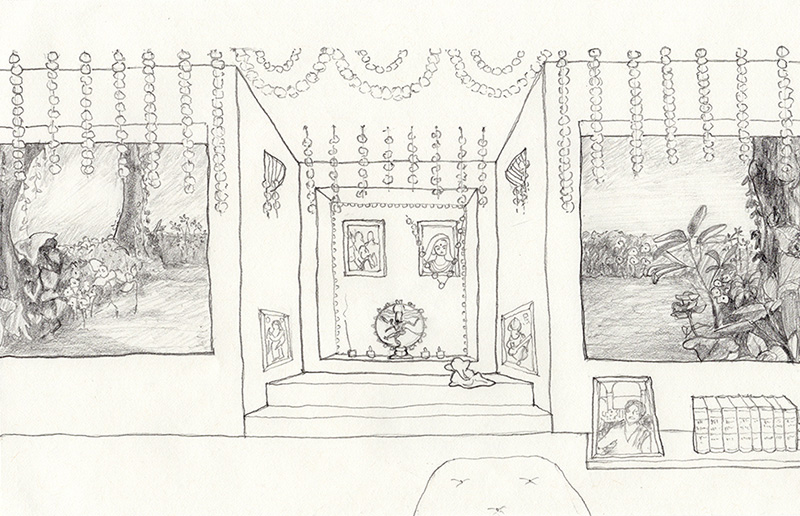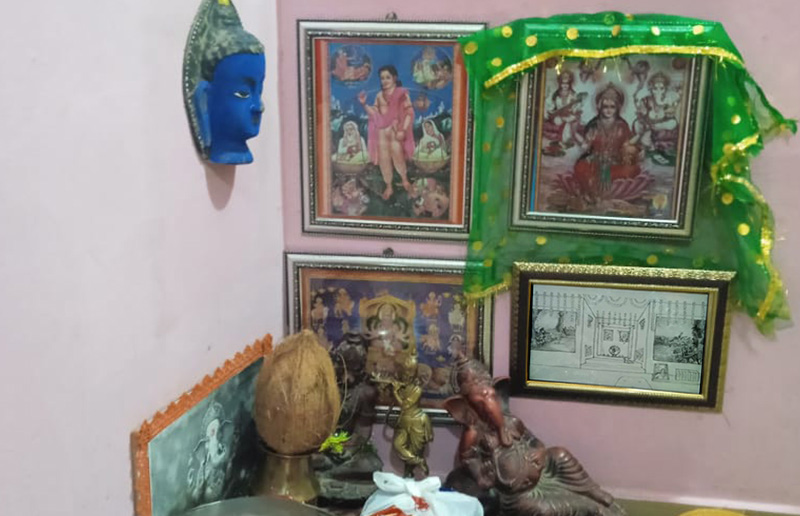

Click drawing


Listen
TranscriptPranavi
12min 47s single channel audio of compiled whatsapp voice notes.
Translated by Yaminay Nasir Chaudhri
A response to your third question: “if I want to make a space in my house that is especially for me what would it look like?” So as I said earlier, that small room that is dedicated to a mandir is what I would want for my room. Mandir means shanti [peace]. Where I can sit and meditate for a few hours. Where for a few moments I can separate from the world and connect with that place which is reality. To connect to that place. To connect to myself. Leave the world of hustle bustle, leave every busy detail. I would like to meditate; feel myself in this place. How would I decorate this room? So I think I would put images and statues of Bhagwan. These will imbue my space with the sacred and automatically I will have the emotion I need to meditate. I would like pictures of some people in this space because of whom my life was transformed, my way of thinking was changed. They made me aware of the truth. They told me about the reality of life. By listening to them I changed myself. I got to learn the truth that is important for all of us yet we don’t want to go there. I would like to put their pictures up in that room: Guru ee, B. K. Ashwani jee, Anand Murthi jee. These great people– Shankar Acharya jee. In that room I want all of these things, where I can sit and listen to everything and leave the world to enter a state of shanti. That’s all…that’s the kind of room I desire for myself. What else can I tell you? I don’t have too much desire for things, I am a very simple person. Since I have learned the truth of life, desires just don’t materialize. Adhoc dreams don’t materialize. Those kinds of thoughts just don't appear. I live in the life of truth. This is all thanks to these people who have changed the way I think.
So in my room I just want to remember these people and walk the path they have shown me to achieve shanti. I want such a room for myself. I hope I have been able to answer your third question. To me, this is my existence for which I strive.
Jee Yaminay jee, assalamu alaikum, how are you? I forgot to add some things in my answer to your third question. These are also quite important for me so I thought I should share them with you. In the room I want for myself, I would also keep some books. My connection with books has been severed for quite some time. As in, I don't study them anymore, but I used to. Since childhood I have had a zeal for books. But it has been a while and I have not been able to carve out time for books because of my engagements with life. Life has become so busy. I would like to put these books in my room: Bhagavad Gita, Ramayana, Upanishads, these will be necessary as they are essential parts of my life. Besides these there are other books I would also like to keep. Books that I want to read. This is a very important wish that I forgot to tell you yesterday. Second, I also forgot to mention that I want to keep a picture of my parents in that room. In the room reserved for special feelings. Of course, these represent every human’s most important relationships. Without parents we are nothing. They teach us all the essential rites of life–we are what we are because of them. I thought I’d share these thoughts with you. Thank you.
Assalamu alaikum Yaminay jee, how are you? Thank you for your condolences. You were asking about windows. Yes, windows are essential for this space. Also, windows should be placed according to the candles we light. For praying, this room needs to be quiet, no pollution…as needed one should be able to open the windows for air to flow into this room…for praying one really needs silence. I imagine meditation requires this.
Assalamu alaikum Yaminay jee, how are you? The picture I just sent you looks good to me. The windows look appropriate to show the scenery outside. For the garden–I had told you some ideas but I lost all my messages on my phone so I am recalling what I mentioned earlier and what I have in mind now. Outside, the garden should be filled with flowers of all kinds, especially roses. All the plants should be groomed very beautifully so the garden looks beautiful. Green grass and colorful flowers. The order should be such that the garden looks very beautiful. That's what's in my mind. Inside, there should be light (maybe white) curtains on one wall. Pictures on the wall as I mentioned before. Light for the room should be normal. Lamps. Beautiful lamps. Not too much decoration, but shades that look like flower vases. Flower Garlands decorating and falling down the walls. Basically the use of flowers inside the mandir. As soon as someone enters the room their heart should rush to beauty. When I look on the net for designs of mandirs–there are so many beautiful designs–but I am sure they must be very expensive. I wish I could afford to buy some of them for my house. Mandir design is very different. If you search on the net you will see them. My room should look like that. I hope I am able to explain what I am thinking to you. OK. Thank you so much.
Assalamu alaikum Yaminay jee, how are you? I am afraid you are getting delayed because of my tardiness. I have pulled out two mandirs for you to take a look at. Choose the one you think is better. There are so many on the internet one can't even look at all of them. And, this is the scenery I have sent you. If you can make the garden like this, it will look very beautiful. It is a bit wild but it looks beautiful. OK. Thank you so much. Allah Hafiz.